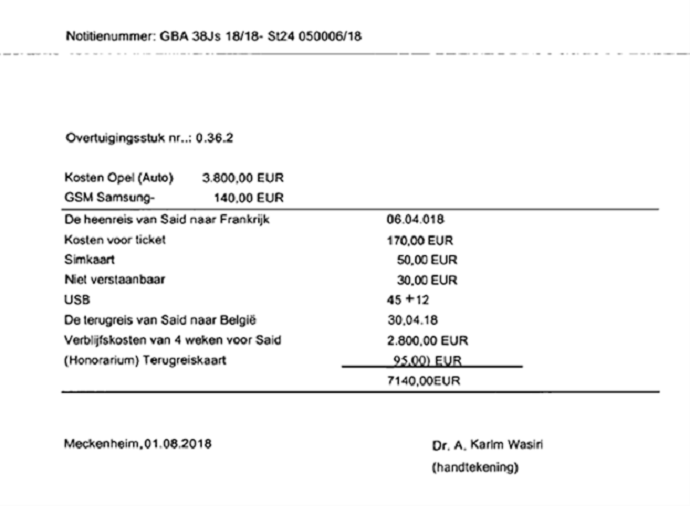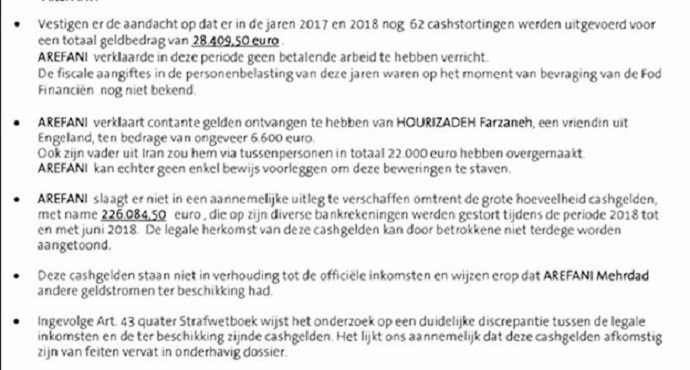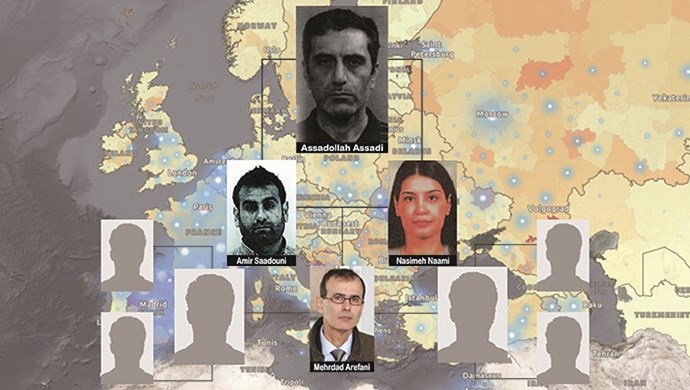Reporting by PMOI/MEK
Iran, January 26, 2021—New evidence found in the case of the prosecution of Assadollah Assadi, an Iranian regime diplomat charged with plotting a terror attack against an annual gathering of the Iranian opposition in 2018, suggests he had been running a large network of spies and agents across Europe. The targeted gathering, organized by the National Council of Resistance of Iran (NCRI), was held in Villepinte, near Paris. According to the arrested suspects, the main goal of the plot was NCRI President-elect Maryam Rajavi.
In their investigation, European authorities found a codebook and a notebook containing cash receipts and payments of several thousand euros. The German Federal Criminal Police Office (BKA) and its intelligence services have launched an investigation to uncover a large spy network led by Assadi in Europe.
During Assadi’s arrest on July 1, 2018, the German police discovered a body of evidence in his rented car, a red Ford S-Max. Among them was a black notebook that contained coded instructions for operating the bomb that was to be exploded at the gathering. Another checkered green 200-page notebook contained of receipts that showed Assadi had distributed a huge amount of cash among various agents in Europe. Because of his extensive travels to various European countries, the German authorities are very much interested in the documents.
Also, in another green booklet, the police found a total of 289 manuscript notes in Latin and Persian, which include the addresses of resorts, shops, hotels, and restaurants, Assadi had visited. In each case, the time and date were mentioned.
The information relates to 11 countries, including France, Austria, the Czech Republic, Hungary, Belgium, the Netherlands, and Italy, but about 144 notes are in particular related to locations in Germany.
One of the notebooks contains the address of the Islamic Center of Hamburg, an association of Shiite mosques that is being closely watched by the German Internal Security Service. According to the Hamburg Constitution Protection Office, the center operates “to export the Islamic Revolution,” a motto that the Iranian regime has been using since the 1979 revolution.
This shows that Assadi presumably runs a bigger network of spies, agents, and informers. In one of his notes, he mentions the name Said, which is Amir Saadouni, one of the operators of the failed bombing plot. Assadi mentions Saadouni’s travel costs and tickets, as well as the payments he received and other purchases he made.
For years, Saadouni and his wife Nassimeh Naami pretended to be supporters of Iran’s main opposition movement, the People’s Mojahedin Organization of Iran (PMOI/MEK). For over 10 years they handed over information about MEK’s internal meetings, demonstrations, rallies, gatherings, members, and sympathizers to Assadi in exchange for money. Both were arrested before the Villepinte meeting while being in possession of the bomb. A fourth agent, Mehrdad Arefani, was arrested at the venue of the event. All three are standing trial in Antwerp, Belgium, along with Assadi.

Assadi’s notes regarding Amir Saadouni’s travel costs and wages.
Saadouni has repeatedly confessed that he regularly received 3,500-4,000-euro payments from Assadi.

Dutch translation of Assadi’s of costs he paid for Amir Saadouni, the main operator of the bomb attack.

The fourth suspect, Mehrdad Arefani, couldn’t explain to the Belgian police the 226,086 euro cash he had transferred to his account.
Assadi’s green notebook contains a long list of paid and unpaid people who are probably parts of the regime’s network of agents in Europe. The police are still investigating this information.
Also according to German BKA analysis of Assadi’s purchase receipts, he always paid in cash.
What has caught the police’s attention is that he had several receipts with him which show cash payments. Recipients had very common Iranian names and their identities have not yet been determined. For example, one of them received 2,500 euros, another 5,000 euros and another person confirmed the receipt of a laptop. Officers speculate that these could be the salaries of people who were hired for spying.
Also, Assadi was arrested with more than 11,000-euro cash which is considered to be the reward for Saadouni and Naami who were supposed to meet Assadi in Cologne after the Villepinte operation.

35,000 euro’s cash was found by the police in Nasimeh Naami’s home in Wilrijk district of Antwerp.
During police interrogations, Nasimeh Naami confessed that she has received 35,000 euros from Assadi. Given that Assadi was rushing back to Austria, he didn’t need such a huge amount of money for his “vacation trip” as he claimed. Therefore, this is considered by the police as a bonus for the operators of the bomb attack.
On June 28, while Assadi handed over the explosives to Saadouni and Naami in Luxembourg, he gave them an envelope with 20,000 euros cash. The three were not aware that they were being watched by a team of police from June 25 to July 1.
The Belgian prosecutor demanded the maximum sentence of 20 years in prison for Assadi and his accomplices for an attempted terrorist murder and participating in activities of a terrorist group. The Criminal Court of Antwerp will issue its verdict on February 4.
The Assadi file is just one of the regime’s many hidden campaigns against the Iranian opposition.
On January 19, U.S. authorities arrested Kaveh Afrasiabi for being an “unregistered agent of the Iranian government.” For many years, Afrasiabi lobbied U.S. officials, published books and articles advancing the Iranian regime’s political agenda while being secretly employed by the regime’s mission to the United Nation. Among Afrasiabi’s key missions was the demonization of the Iranian Resistance.
Also, the previous remarks by the regime’s former head of intelligence Ali Fallahian proves the regime uses diplomatic cover, journalists, businessmen, and analysts for intelligence work.
“The Intelligence Ministry needs a cover to gather intelligence, both inside and outside of the country. We will not send an MOIS (regime’s Ministry of Intelligence) agent to a country by introducing himself as an agent. We work under cover of business jobs and journalists and we work under all kinds of covers,” Fallahian acknowledged.





